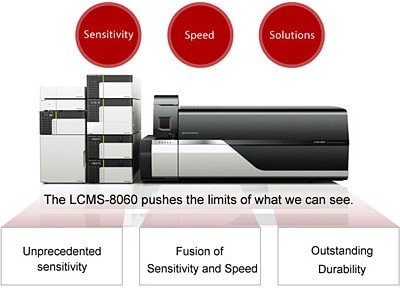Future trends of LCMS
Although there are lots of ongoing efforts and developments on LCMS, there is still more to be explored to fully unleash the capacity and potential of LCMS. Future trends and developments of LCMS are expected to still focus on achieving better performance in terms of higher throughput, quality, efficiencies and robustness.
One such development is the integration of various LC separation modes such as two-dimensional LC (2D-LC) and nano/capillary flow LC into LCMS platform. Progress is ongoing and it can improve the separating power and sensitivity of LCMS. This technology is promising for impurity analysis in pharmaceuticals and protein identification. If made easily comprehensible, it is expected to break into widespread industrial use in the near future. There are also efforts from LCMS manufacturers in designing a more compact, lighter and greener LC system for LCMS, that requires less amount of materials, consume less volume of solvents and having less dead volumes.
Another trend aims to get more while doing less, that is to move towards minimal sample preparation without compromising on data information and quality. As discussed earlier, current sample preparation processes tend to be a laborious, time-consuming and repetitive. Therefore, the simplification of these processes and even the use of automation for LCMS is favored and future developments are expected to head towards this direction. Another approach to achieve greater throughput would be a development of sophisticated software to enable multiplexing. For example, by shifting from the original serial data acquisition to parallel data acquisition, allowing more samples to be analyzed in a shorter period. With the combined efforts in sample preparation, software developments and data integration, the streamlining of LCMS workflow from the initial sample preparation to the final data analysis enables LCMS to be a one-stop, highly reliable, efficient and automated process.
Given its strengths and versatility, LCMS is expected to continue to be the analytical technique of choice for both quantitative and qualitative analyses in many applications. However, to allow the market to enjoy the multitude of benefits that LCMS can bring to their analysis, LCMS providers will need to reach out to them and knock down the markets' perceived barriers to LCMS.
In conclusion, LCMS is a powerful and versatile tool equipped with both separating and detection capabilities. This fundamental guide covers the key concepts and principles of LCMS and describe the various types of LCMS and LC-MS/MS instruments in details. We hope that the contents provide you with a comprehensive overview and assist in your LCMS analyses. Driven by our policy of contributing to society through science and technology, we strive to further improve our technologies, create unique solutions and innovative breakthroughs with a diverse product range to protect and restore the environment, and to deliver better health and lifestyles to people.



